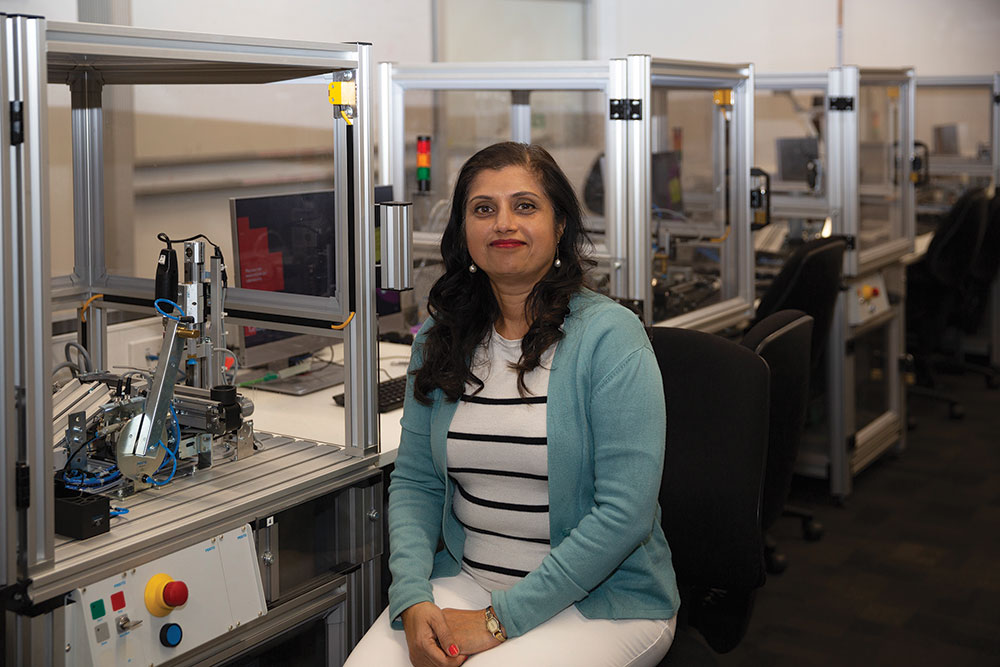Sufferers from pelvic organ prolapse, a condition associated with childbirth and menopause, have long been overlooked. This engineer hopes to provide an effective treatment.
The use of transvaginal mesh implants have been a treatment for a common, yet often debilitating, condition that affects millions of Australians called pelvic organ prolapse (POP).
The use of the mesh implants has been associated with serious side effects and was banned in Australia in 2017. A Senate inquiry the following year found women who suffered from their insertion were “ignored” and “treated appallingly”.
An effective long-term treatment for POP has yet to be developed but, thanks to a new project led by RMIT and Monash University engineer Dr Gita Pendharkar, that could be about to change.

Suffering in silence
POP occurs when pelvic organs such as the uterus, bladder or bowel descend into the vagina. It can be caused when the pelvic floor muscles, ligaments and tissue that hold the organs in place are weakened or damaged during experiences such as childbirth or with the hormonal changes that occur with menopause.
“POP affects 50 per cent of women who have given birth and 50 per cent of women aged over 50,” Pendharkar said.
“It’s a significant problem, but women have tended to suffer in silence and it’s a condition that has long been overlooked in terms of effective treatments.”
Symptoms include pelvic heaviness, incontinence and difficulty urinating, which can lead to recurring urinary tract infections.
These symptoms can be helped through physiotherapy, but the most severe cases may require surgery. More than 30 per cent of patients have a recurring prolapse. Many procedures are also under close scrutiny due to the transvaginal mesh scandal.
A smart solution
Pendharkar and her team are developing a smart electronic device to counter the debilitating symptoms. The device uses intelligent sensing and signal processing techniques, along with “stimulators”, to rehabilitate pelvic floor muscles as well as alleviate symptoms of the condition as patients age.

The idea for the device was developed by engineer and Monash University PhD candidate Ritesh Warty, who learnt about POP after discussing the potential applications of 3D printing in obstetrics and gynaecology with a colleague.
“I was really surprised by how common POP is and that there has been so little innovation in the area to help women who experience it,” Warty said.
Warty had previously developed a stimulator to successfully treat a hernia injury he’d developed during mixed martial arts class.
“I included the concept for the POP device in my scholarship application a few years ago and one of the professors from the Department of Obstetrics and Gynaecology approached me last year and suggested we start working on it together,” he said.
“I’m still a junior engineer, so I knew we needed an engineer who has a lot more experience than me … The first person I thought of was Gita.”
Pendharkar grew up in Mumbai. Her passion for science, curiosity about how things work and some encouragement from her father led her to pursue a career in electronics engineering. She moved to Australia with her husband and two daughters in 2000 and, after being awarded a scholarship, completed her master’s in electrical and electronics engineering at the University of Melbourne.

Pendharkar then began a PhD at Monash University, where she collaborated with Monash Medical Centre to develop a device for monitoring and assessing the gait in idiopathic toe walking children — children who walk on their toes for no identifiable reason. Its application was later extended to helping patients with stroke, diabetes and Parkinson’s disease.
“My interest in medicine and engineering combine in the biomedical space,” Pendharkar said.
“I’ve always wanted to understand how the body functions. This area of medicine has multiple complexities and if engineers can help to solve some of these complexities, they become a priority to help mankind.”
Treatment and cause of pelvic organ prolapse
Finding an effective treatment for POP is the current priority for Pendharkar and her Monash University team.
In addition to Warty, the team includes clinicians Professor Caroline Gargett, Associate Professor Anna Rosamilia and engineering honours student Naween Dehigaspitiyage Don.
The smart device is designed to be housed in a pessary, which is shaped like a ring. It includes an array of sensors that monitor and profile the pelvic area, and a stimulator that helps with muscle toning and strengthening.
“The sensors will detect whether the condition is improving or getting worse, and clinicians will use this information to decide whether the patient requires the stimulation,” Pendharkar said.
She added that stimulation has become a popular technique to improve muscle tone.
“This stimulation will also train the patient’s pelvic floor muscles to better support the descendant organ and, hopefully, strengthen the muscles so that they can push the organ back into position,” she said.

Driving change
Along with her role as an Adjunct Research Fellow at Monash University, Pendharkar has been Project Lead for Women in STEM at RMIT’s College of Vocational Engineering Health and Sciences, and is now Program Coordinator of Engineering, Electrical and Telecommunications Programs.
In 2018, she was awarded Mentor of the Year in the Women in Industry Awards, which recognise women who are driving change in their industry. Pendharkar is working to break down barriers through education and increase the representation of women in STEM vocations.
“I feel like I’m working on a project which could take about a hundred years to complete, because progress for women in STEM is so slow,” she said.
It’s a huge, complex issue, Pendharkar said.
“I believe that talking to children and teachers in schools about emerging technology is really important,” she said.
“We need to motivate girls to explore engineering and science, because they can make a real difference.”
Before the COVID-19 pandemic began, Pendharkar hosted face-to-face science and engineering workshops to promote STEM to girls in secondary school. Last year, the workshops were conducted virtually.
“One of the online workshops involved first-year students teaching the high-school kids about robotics,” she said.
“A robot that could lift a pen or move a piece of paper was demonstrated — it was straightforward, routine, but it was all mechanically assembled and programmed by the first-year students who explained it to the school kids.”
Engineering can make a meaningful difference in people’s lives, says Pendharkar, and her smart device to treat POP is a testament to this. Currently in prototype stage, the team aims to start clinical trials next year.
“This is such a common condition and so many women don’t talk about it,” she said.







Absolutely brilliant, innovative concept. Women around the world absolutely suffer in silence, we hear their voices daily in our support space. The impact of pelvic organ prolapse to women’s quality of life is physical, emotional, social, sexual, fitness, and employment. Zero doubt the biggest hit is to self-esteem; vaginal health is so highly stigmatized.
We truly need more innovation in this space. Nearly 4000 years of medical documentation, estimated 50% prevalence, childbirth and menopause leading causal factors, it is absurd at this point in time we are still in need of a better system to address the shortfall in awareness, screening, practice, and policy. We have much work to do. Vision like this gives me hope for the women we serve.
Sherrie Palm, Founder
Association for Pelvic Organ Prolapse Support
What is the pelvic floor exercise machine called that would be helpful?
Are you trying to find a safer way to help women with pelvic floor pain symptoms lift their pelvic up again?
As one who suffers from POP on a daily basis, I thrilled and relieved to read that innovative help is on the way. This is exciting news for me, my daughter, and granddaugters. I am a retired school teacher who always encouraged my girl students to excell in math and science courses.
This would be life changing. I have suffered with POP every day since giving birth 45 years ago as well as after menopause. It effects every thing you do such as laughing, coughing, running & jumping. You must plan ahead, reduce drinking fluid quantity & know where toilets are everywhere you go. I had an operation which helped partially but didn’t fix the problem. I must do pelvic floor exercises every day which help to control it but doesn’t work 100%. A better way of training the muscles would be profound.
I suffer daily with POP. It is painful and rules my life with what I can and can’t do. I am 61 years old and I’ve been told by a male gynaecologist that there is nothing he can do to help me. Surgery took my cervix years ago when I had a hysterectomy and oopherectomy so a pessary doesn’t work for me. This device would be a lifesaving answer for me. Excited
All the above comments apply to me too. I have had two bladder ops, not having a third. I too need to know where all toilets are, I just stay at home mostly because of this problem. Even then I don’t always make it to the toilet in time. It’s too late for me but I hope and wish for better treatment for the younger generation. Having women working in this field will help enormously, they can understand ,men unfortunately really have not much of an idea other than the mechanics of the waterworks system. GO THE WOMEN
I found this information riveting as I have a mother who has had ring pessaries fitted but they have failed and her Obstetrician-gynecologist has decided that he can’t help her as she is too old for an operation. And so she suffers.
I suffer from POP too and need to know where every loo is too. I’ve had a hysterectomy plus bladder and bowel prolapse surgery, but still having problems. I’d be most interested in taking part in trials, though probably couldn’t qualify as I live in a more remote rural area.